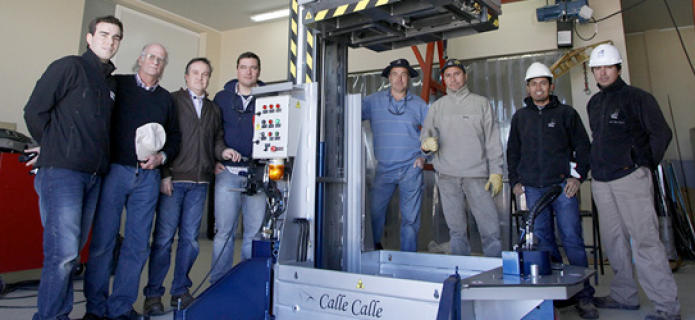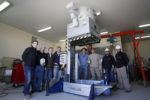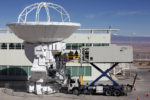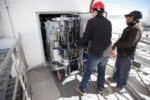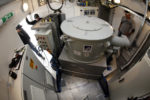New ALMA Equipment Designed in Chile
New equipment for transporting one of the most sensitive components of the ALMA array — the antennas Front End (cryogenic refrigerators) — has been delivered to ALMA by the National Radio Astronomy Observatory (NRAO), the North American associate of the Atacama Large Millimeter/submillimeter Array. This new vehicle, which will save lots of time and increase safety during maneuvers, was completely designed and built in Chile. It is the first shipment of one of four vehicles for handling the Front Ends that hold the set of detectors inside ALMA´s antennas, and is part of the technological exchange policy with the host country.

The team that delivered the FEHV to ALMA, from left to right: Pablo Walper, Ricardo Hohf, Juan Carlos Mättig, Rodrigo Brito, Martin Mündnich, Pablo Carrillo, Cristobal Jara and Luis Villagra. Credits: Carlos Padilla, AUI/NRAO.
The Front End Handling Vehicle (FEHV) — a robust elevator-crane car — is the result of a three year design and manufacturing collaboration between NRAO and a team of Chilean professionals from the Prolaser and Maestranza Walper companies, located in the city of Valdivia, in the south of Chile. The main tourist attractions of this region inspired the names of each of these four vehicles, being the first one called after a river: "Calle-Calle".
The FEHV will help shorten the time of set up and remove of the receivers from the antennas. "This replacement job takes place each five days. Using this vehicle during the 30 year lifetime projected for the observatory, will save a whole lot of resources, considering that this specific task takes 2000 man/hours a year, approximately", proudly stated Rodrigo Brito, team leader supervising the official shipment of the manufacturing contribution from the North American partner of ALMA.
Up. FEHV is lifted inside a cabin for maintenance of the antenna´s Front End. Credits: Carlos Padilla, AUI/NRAO. - Down. A FEHV getting into an antenna. Credits: Carlos Padilla, AUI/NRAO.
Each cryostat, together with receivers composing each Front End, costs about one million dollars, weighs around 750 kilograms and must be lifted almost 2 meters up to stand in a precise position in the confined space inside the antennas cubicles. The FEHV has a built-in platform to lift its load in a safe way, move it and rotate it for perfect alignment during the set up. It weighs 709 kilograms and it´s 2,20 meters long, 1,05 meters wide and 1,50 meters tall.

FEHV elevator crane in the final stage of its delicate load (Front End) inside an antenna. Credits: Carlos Padilla, AUI/NRAO.
More Information
The Atacama Large Millimeter/submillimeter Array (ALMA), an international astronomy facility, is a partnership of Europe, North America and East Asia in cooperation with the Republic of Chile. ALMA is funded in Europe by the European Southern Observatory (ESO), in North America by the U.S. National Science Foundation (NSF) in cooperation with the National Research Council of Canada (NRC) and the National Science Council of Taiwan (NSC) and in East Asia by the National Institutes of Natural Sciences (NINS) of Japan in cooperation with the Academia Sinica (AS) in Taiwan.
Contact:
Valeria Foncea
Education and Public Outreach Officer
Joint ALMA Observatory
Santiago, Chile
Tel: +56 2 467 6258
Cell: +56 9 75871963
Email: [email protected]
